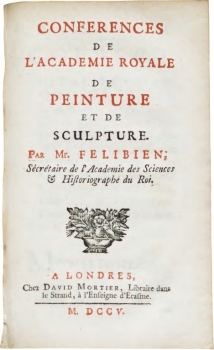From my first book, La couleur éloquente (1989; English translation, The Eloquence of Color, 1993), to the multivolume critical edition Conférences de l’Académie royale de peinture et de sculpture (2007–2010), edited with Christian Michel, my research has been devoted to subjects that have generally been considered outside the field of philosophy, belonging rather to those of art theory and art criticism. My subjects were not works of art—which lie outside my discipline—but discourses on art and works of art; more specifically, on painting and sculpture. Until now I have worked mainly on the various discourses that have developed within the field of art since the Renaissance, focusing my research on theories of art that were formulated by artists themselves. The conférences of the Académie royale de peinture et de sculpture are undoubtedly some of the best examples of this artistic theory of art, and that is why Professor Michel and I decided to publish them.
On the one hand, my current project is quite different from my previous ones; on the other, it is entirely based on them. It is what I would call an epistemological inquiry. I want to analyze what distinguishes or even sets in opposition the different types of discourses on art that have coexisted since the middle of the eighteenth century: those of the art theoretician, the art critic, the art historian, and the philosopher.
Why the eighteenth century? Because in this period a major breach in the history of artistic discourse emerged. An earlier breach had appeared during the Renaissance with the birth of the theory of art in its modern sense, which represented a new mode of reflection on art and a different understanding of artistic practice as a theoretical enterprise. A second important breach occurred around 1750 with the appearance of three completely new types of discourse: art criticism in France and art history and aesthetics in Germany. These discourses are in fact very different from one another. Art criticism is a literary genre whose development was linked to the new modes of exhibition (salons) and publication (newspapers). In contrast, art history pretends to be a scientific approach to art, and it very quickly gained the legitimacy of an academic subject in the German university. Aesthetics is the name given in Germany to a new branch of philosophical study (separate from metaphysicis, logic, and so on) that emerged following the publication of Gregor Baumgarten’s Aesthetica in 1750. Beyond the theoretical concerns that differentiate them, these discourses share their development outside artistic practice. Although art critics, art historians, and philosophers do not adopt the same position toward art and artistic works, they have in common the fact that they are not artists themselves.
This position outside the practice of art is what distinguishes their discourses from that of artists. It explains the hostile reaction of the academicians to art critics like Étienne La Font de Saint-Yenne and Denis Diderot, who claimed proudly not to be artists themselves—that is, they judged art purely from the point of view of a spectator. But it also explains the French resistance or opposition to the historical, and, even more, to the aesthetic approach to art, which until the second half of the nineteenth century would be identified as a typically German mode of thinking, foreign to the French tradition of artistic theory.
In my book I will explore the properties of the various discourses on art that emerged in the eighteenth century and analyze their differences, limits, and specificity. I will also consider the “national” aspect of the opposition between different modes of discourse; that is, how this theoretical and artistic conflict was shaped, in the eighteenth and nineteenth centuries, into a more general and political antipathy between France and Germany. Last but not least, I will examine the current situation and ask: what are the relationships today among art theory, art criticism, art history, and aesthetics? I also want to address a question that is crucial for me as a philosopher: does philosophy have something specific to say about art?
